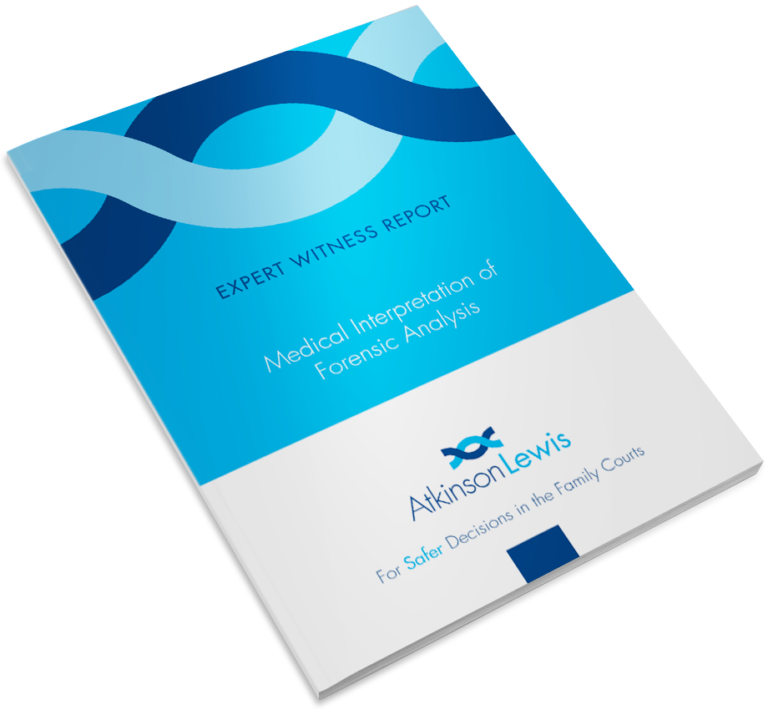Hair Alcohol Testing
- Screening for: twin alcohol markers EtG & FAEE (EtPa)
- Detection Window: 10 days to 6 months
Hair Testing: the first step to proving excessive consumption of alcohol
In custody cases, every hair strand tells a story. But it never tells the whole story – as noted in Justice Moylan’s landmark ruling of 2010.
After hearing a case that relied heavily on hair alcohol testing, he issued a Neutral Citation stating “You cannot put everything on the hair test”. He concluded that courts should see hair as part of an evidential picture – valid when combined with blood alcohol tests and medical interpretation.
At Atkinson Lewis, we only carry out hair alcohol tests on that strict understanding.
As with hair drug testing, it all begins with a sample: 3-6cm of hair that will harbour evidence at an average rate of 1cm per month. There’s a 10-day “blind spot”, masking alcohol consumed up to a week before collection – but when that missing time is filled in by blood tests, the lab can start to establish a pattern of excess.
What are we testing for?
In a word, ethanol. It’s the intoxicating agent in alcohol, and its metabolites linger in different parts of the body for different lengths of time. They stay in hair for 3-6 months, so they’re useful markers for a long-term drinking habit.
In a standard hair alcohol test, we search for two types of metabolite:
- Ethyl Glucuronide (EtG)
- Fatty Acid Ethyl Esters (FAEEs) – notably Ethyl Palmitate (EtPa)
When alcohol is consumed to excess, we’d expect to find both of these molecular clues. So each one helps to confirm the other, and we know there’s a case to answer.
However, metabolites attach to the hair strand in a chaotic way, diffusing over time. So the hair strand won’t reveal the same linear timeline that you’d get from a drug test. For alcohol, it’s safer to view the hair strand as a block of time – a broad indication of alcohol use over the months in question.
Where does Medical Interpretation fit in…and why?
As noted by Justice Moylan, hair testing results must be viewed in context because there’s too much scope for misinterpretation. For example…
No Visible Pattern
A test can show excess levels of alcohol, but can’t show how or when it was consumed. So we can’t say how often the client drinks, or how much on each occasion. The upshot being, a social drinker and binge drinker could score the same in a hair test.
Conflicting Results
It’s quite common for a parent to test positive for FAEEs (EtPa) and negative for EtG – or vice versa. In which case, blood testing and expert arbitration will sway the balance.
False Negatives, False Positives
There’s no guarantee that alcohol will leave traces of EtG and FAEEs (EtPa) – so it’s unsafe to view a negative test as proof of abstinence.
And on the flip side, excess indicators are not necessarily the result of alcohol – so it’s equally unsafe to view a positive test as proof of consumption.
These errors can stem from:
- “Noise” produced by testing instruments
- Contaminants like airborne alcohol in pubs
- Red herrings like alcohol from fermented foods or mouthwashes
- Biological variations – everyone has their own metabolism
- Deceptions like bleaching hair or over-washing to rinse out EtG
- Marginal results, where metabolite levels are borderline
The marginal aspect is especially important. Even for heavy drinkers, a hair strand will only hold small traces of metabolites. So much so, concentration levels are measured in nanograms and picograms per milligram of hair. That creates a low testing threshold, and with it high margins of error – false positives and false negatives both in the region of 10%.
Of course, the blood alcohol test will offset this to a degree, as noted by Justice Moylan. But this is really just a short-term indicator to accompany the long-term results from hair. So any case that hinges on nothing but lab data will be wide open to legal challenges – and more importantly, risks an outcome that’s harmful to the child.
This is why your case needs an expert medical opinion, and why all our cases are overseen by Dr Catherine Pyves – an experienced psychiatrist with specialist knowledge of drug and alcohol misuse among parents.
Dr Pyves’ team will take the quantitative data supplied by our trusted lab partners, and with their continued input, add the qualitative side.
Ultimately, it’s about seeing the parent as a human being: understanding their history, behaviours, environment, routine, plus physical and mental health. It all builds a picture of the person behind the data, in a way that often shines a new light on the case.
Why work with Atkinson Lewis?
- A “Data Plus” approach, putting lab results in context
- Medical interpretation by a drug and alcohol specialist
- End to end support for public and private law cases: from sample collection to lab analysis and medical review
- MIFA Report: an expert witness statement accepted by UK Family Courts
- All testing conducted by trusted partners in ISO/IEC 17025 Accredited Testing Laboratory – certified for multiple tests inc. hair drug testing and hair/blood alcohol testing
- Friendly, non-judgemental sample collectors working in most UK regions – highly trained to follow strict chain of custody protocols
- Transparent pricing for LAA approval
- Split-billing between all parties involved
- Hands-on customer service team, working all hours to take on new instructions


Hair Alcohol Testing is part of our MIFA report:
Medical Interpretation of Forensic Analysis
Or click below for other ways we can support your case:
In Private & Public Law Cases
You Can Rely on Atkinson Lewis
Local AuthorityAn incredible job!
Really helpful staff and second-to-none customer service. They are all really approachable and friendly. The collections are always on time and professional. In fact we have never had to deal with a situation in which they have ever let us down. As a result I think we take their brilliant service a little for granted! Thanks Atkinson Lewis for an incredible job!
ParalegalAlways my first point of call
Very helpful and approachable and always on hand to answer any queries. They are very accommodating in terms of setting up appointments and make the process very easy for legal services. Excellent service provided and always my first point of call for any alcohol/ drug or DNA testing.
How Can We Help You Today?
We’re here to assist with private and public cases in the Family Courts. If you’ve got a question, need a cost or you’re ready with an instruction, give us some details and we’ll get back to you quickly.